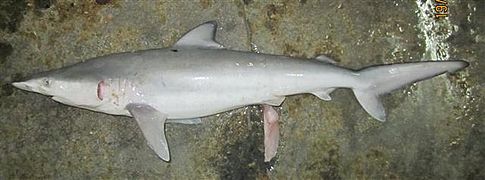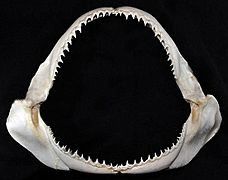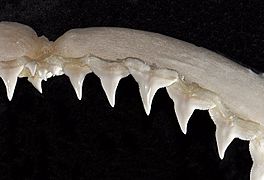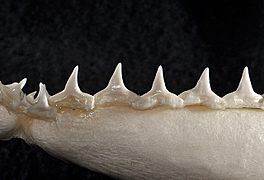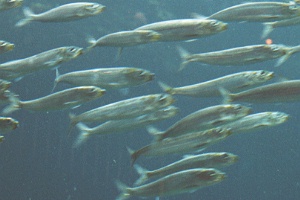Copper shark facts for kids
Quick facts for kids Copper shark |
|
|---|---|
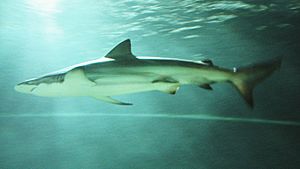 |
|
| Conservation status | |
| Scientific classification | |
| Genus: |
Carcharhinus
|
| Species: |
brachyurus
|
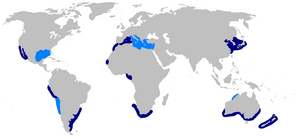 |
|
| Confirmed (dark blue) and suspected (light blue) range of the copper shark | |
| Synonyms | |
|
Carcharhinus acarenatus Moreno & Hoyos, 1983 *ambiguous synonym |
|
The copper shark (Carcharhinus brachyurus) is also known as the bronze whaler or narrowtooth shark. It is a type of requiem shark and is special because it mostly lives in temperate (not tropical) waters. You can find these sharks in different parts of the Atlantic and Pacific oceans. They also live around Australia and New Zealand.
Copper sharks can live in many places. They are found in brackish (slightly salty) rivers and estuaries. They also live in shallow bays and harbors. Sometimes, they go into deeper offshore waters, more than 100 m (330 ft) deep. Female sharks often live separately from males for most of the year. They also travel long distances at certain times.
These are large sharks, growing up to 3.3 m (11 ft) long. It can be hard to tell them apart from other big requiem sharks. Copper sharks have narrow, hook-shaped upper teeth. They usually do not have a ridge between their dorsal fins. Their body color is a plain bronze.
Copper sharks are fast-swimming predators. They mostly eat cephalopods (like squid), bony fishes, and other cartilaginous fishes (like rays). They are known to hunt in large groups sometimes. This helps them catch more food. Off South Africa, they follow the annual sardine run. This is when millions of southern African pilchard (Sardinops sagax) swim together.
Like other requiem sharks, copper sharks give birth to live young. The baby sharks grow inside the mother. They get food through a special connection called a placenta. Females have 7 to 24 pups every two years. They give birth in coastal areas that act as nurseries. It takes a long time for these sharks to grow up. Males are ready to have babies at 13–19 years old. Females are ready at 19–20 years old.
People catch copper sharks for food. They are caught by both commercial and recreational fisheries. The number of copper sharks in the world is not fully known. However, they are listed as vulnerable. This is because they grow and reproduce very slowly. Their numbers are thought to have dropped in some areas.
Copper sharks do not attack humans very often. But they are among the top ten sharks for unprovoked attacks.
Contents
About the Copper Shark Name
The copper shark has been described by scientists many times. This is because it lives in different areas around the world. The first proper description was in 1870. It was made by a British zoologist named Albert Günther. He called it Carcharias brachyurus.
The name brachyurus comes from Greek words. Brachys means "short" and oura means "tail". The name "whaler" came from the 1800s. Whaling crews saw many sharks around dead whales. This shark is also called the black-tipped whaler or New Zealand whaler. Sometimes, people just call it "bronze" or "bronzie".
Where Copper Sharks Live
The copper shark prefers temperate waters. These waters are usually warmer than 12 °C (54 °F). It is the only shark of its kind that mostly lives in these areas. They are found in many places, but in separate groups. These groups do not often mix.
In the Atlantic Ocean, they live from the Mediterranean Sea to Morocco. They are also found off Argentina and South Africa. In the Indo-Pacific, they are found from the East China Sea to Japan. They also live off southern Australia and around New Zealand. In the eastern Pacific, they are found from northern Chile to Peru. They also live from Mexico to California.
Copper sharks are common in some places like Argentina, South Africa, Australia, and New Zealand. They are rare in other areas. It can be hard to know their exact range. This is because they look like other shark species.
These sharks live close to shore, even in the surf zone. They can also be found further out in the open ocean. They can dive to depths of 100 m (330 ft). They often go into shallow places like bays and harbors. They can also live in rocky areas. Copper sharks can handle water that is not very salty. They have been seen in estuaries and large rivers.
Young sharks stay in shallow waters, less than 30 m (98 ft) deep. Adult sharks usually stay further offshore. But they come closer to the coast in spring and summer. At these times, many sharks can be seen together in shallow water.
Copper Shark Migrations
Copper sharks in both the northern and southern parts of the world travel seasonally. They move because of changes in temperature, to have babies, or to find food. Males and females, and young and old sharks, move differently.
Adult females and young sharks spend winter in warmer areas. As spring comes, they move to cooler places. Pregnant females also move closer to the coast. This is where they give birth in special nursery areas. Adult males stay in warmer areas for most of the year. But in late winter or spring, they also move to cooler places. This is so they can meet and mate with females after they have given birth.
During these travels, some sharks have been tracked moving up to 1,320 km (820 mi). They often return to the same areas each year.
What Copper Sharks Look Like
The copper shark has a slim, smooth body. Its snout is quite long and pointed. Its eyes are round and have special protective eyelids. The mouth has small grooves at the corners. It has 29–35 rows of teeth on top and 29–33 rows on the bottom.
Their teeth are serrated (like a saw). The upper teeth have a distinct hook shape. They become more angled towards the sides of the jaw. The lower teeth are straight. Adult male sharks have longer, narrower, and more curved upper teeth than females and young sharks. They have five pairs of long gill slits.
The pectoral fins are large and pointed. The first dorsal fin is tall and has a pointed top. It starts around where the pectoral fins end. The second dorsal fin is small and low. It is usually opposite the anal fin. There is usually no ridge between the dorsal fins. The caudal fin (tail fin) has a well-developed lower part.
This shark is bronze to olive-gray on top. It often has a metallic shine or a pink tint. The tips of the fins may be darker. But the color quickly fades after the shark dies. The underside of the shark is white. This white color extends up the sides in a clear band.
It can be hard to tell a copper shark from other large Carcharhinus sharks. For example, it looks a lot like the dusky shark (C. obscurus). But you can tell a copper shark by its upper tooth shape. It also has no or a very small ridge between its dorsal fins. And its fins do not have clear markings. Copper sharks can grow up to 3.3 m (11 ft) long. They can weigh up to 305 kilograms (672 lb).
Copper Shark Behavior and Diet
Copper sharks are fast and active. They can be seen alone, in pairs, or in loose schools of hundreds of sharks. Some groups form to find mates. Others form when there is a lot of food. Larger sharks and killer whales might hunt copper sharks.
What Copper Sharks Eat
Copper sharks usually hunt closer to the bottom of the ocean. They eat cephalopods like squid and octopus. They also eat bony fishes such as tuna, sardines, and anchovies. They also eat cartilaginous fishes like dogfish sharks, stingrays, and skates. For sharks longer than 2 m (6.6 ft), cephalopods and cartilaginous fish become more important food. Young sharks also eat jellyfish and crustaceans like prawns.
Copper sharks do not attack marine mammals. But they have been known to eat dead dolphins caught in fishing nets. Off South Africa, their main food is the southern African pilchard. These pilchards make up 69–95% of their diet. Every winter, many copper sharks follow the "run" of these pilchards. This happens from the Eastern Cape to KwaZulu-Natal. Millions of these small fish attract many predators, and copper sharks are the most common shark there.
Many copper sharks have been seen hunting together. They seem to work as a team. They "herd" small schooling fish into a tight ball. Then, each shark swims through with its mouth open to eat. For larger prey like tuna, the sharks might form a "wing" shape. This forces the prey closer together. Each shark then targets a specific fish and attacks in turn. In False Bay, South Africa, these sharks reportedly follow fishing boats.
In New Zealand, there have been reports of copper sharks being attracted to swimming kids. They seem especially interested in those jumping off yachts.
Copper Shark Life Cycle
Like other sharks in its family, the copper shark gives birth to live young. The mother nourishes the developing babies inside her. Adult females have one working ovary and two working uteruses. The male bites the female before mating. In the Southern Hemisphere, mating happens from October to December. This is when both male and female sharks have moved to offshore waters.
Births seem to happen from June to January, with most in October and November. Female copper sharks use shallow coastal areas as nurseries. These places have lots of food. They also keep the baby sharks safe from bigger sharks.
Known nursery areas are off northern North Island in New Zealand. They are also off Albany and in Port Phillip Bay in Australia. Other nurseries are off Niigata (Japan), the Eastern Cape (South Africa), and in the Mediterranean Sea. They are also found off Rio de Janeiro (Brazil) and Buenos Aires (Argentina). In the eastern Pacific, nurseries are off Paita (Peru) and in San Diego Bay.
Most experts believe the babies grow inside the mother for 12 months. Some information suggests it could be 15–21 months. Females have babies every two years. They have 7 to 24 pups, with an average of 15 or 16. Females off California and Baja Peninsula tend to have fewer young. Newborn sharks are about 55–67 cm (22–26 in) long.
The copper shark grows very slowly. Off South Africa, males are ready to have babies at 2.0–2.4 m (6.6–7.9 ft) long, when they are 13–19 years old. Females are ready at 2.3–2.5 m (7.5–8.2 ft) long, when they are 19–20 years old. The longest they are known to live is at least 30 years for males and 25 years for females.
Copper Sharks and People
Shark Attacks on Humans
Copper sharks do not attack humans very often. But they are listed as the tenth shark species for unprovoked attacks. By 2013, the University of Florida recorded 20 attacks by this species. (For comparison, great white sharks had 279 attacks.)
Even though they are big and strong, copper sharks are not usually aggressive towards people. This changes if there is food around. Copper sharks have been known to bother spear fishers to try and steal their catch. They have bitten swimmers in Australia and New Zealand, where they are common. In these places, they are often called bronze whalers.
Some fatal attacks have been linked to copper sharks. These include a swimmer's death in 2014 in Tathra, New South Wales, Australia. Also, a swimmer died in 1976 in Te Kaha, New Zealand. About three out of ten shark attacks in New Zealand are thought to be by copper sharks.
It is hard to count attacks by copper sharks. This is because they look so much like other requiem sharks. People who see or are involved in an attack might not correctly identify the exact shark species. Experts say that statistics might not show the true number of attacks by sharks like the copper shark.
Copper Sharks in Aquariums
Like many large, active sharks, copper sharks do not do well in captivity. They tend to bump into the sides of their tanks. This can cause injuries that get infected and can be deadly.
Fishing for Copper Sharks
Commercial fisheries catch copper sharks in many places. These include New Zealand, Australia, South Africa, Brazil, and Mexico. They are caught in nets and on long fishing lines. They are also sometimes caught by accident when people are fishing for other things. Their meat is sold for people to eat.
Copper sharks are also popular with recreational fishers. People catch them for sport in places like Namibia, New Zealand, and California. In New Zealand, they are the most common Carcharhinus shark caught by sport fishers. There is a small summer fishery in northern North Island. It mainly catches pregnant females and those who have just given birth. Most of these sharks are tagged and released. A tag and release program is also used in Namibia.
Protecting Copper Sharks
The International Union for the Conservation of Nature (IUCN) says the copper shark is vulnerable worldwide. This means their numbers are at risk. We do not know the total number of copper sharks. But they grow slowly and do not have many babies. This makes them very sensitive to overfishing.
In Australia, New Zealand, and South Africa, the IUCN lists this species as "Least Concern". This is because fishing in these areas is usually well-managed. The copper shark populations in these countries mostly stay within their own waters. New Zealand's reported catches have gone down. But it is not clear if this means fewer sharks or just changes in fishing.
In the eastern Pacific, copper sharks are rare. Not much is known about fishing for them there. So, they are listed as "Data Deficient". However, shark and ray catches have gone down in the Gulf of California. Off East Asia, the copper shark is listed as "Vulnerable". Shark numbers in general have dropped a lot in that region.
Other threats to copper sharks include their coastal nurseries being damaged. This happens from building, pollution, and fish farms. They can also die in shark nets used to protect beaches. Sometimes, fish farmers in southern Australia also harm them.
The New Zealand Department of Conservation says the copper shark is "Not Threatened" in New Zealand. But they add that it is "Conservation Dependent" and "Data Poor".
See also
 In Spanish: Tiburón cobrizo para niños
In Spanish: Tiburón cobrizo para niños



